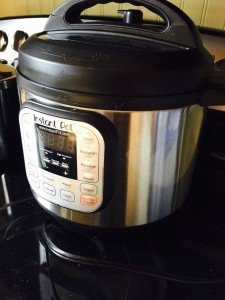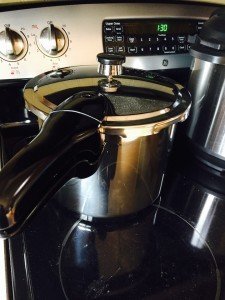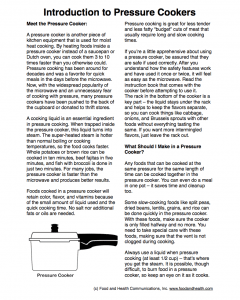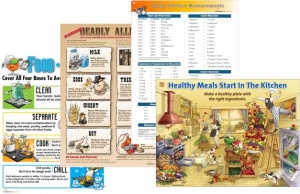Under Pressure: Cooking with Pressure Cookers
 I just finished testing pressure cookers and... I love them!Seriously.Pressure cookers aren't nearly as scary as most people think. They're not dangerous, they're not complicated, and they're great at making nutrient-dense, flavorful food.It's just a matter of getting started on the right foot. To help you and your clients do just that, I've put together tips and tricks for using a pressure cooker, links to some of my favorite pressure cooking resources, a free handout, and a list of 10 things that my team and I learned while testing pressure cookers. By the time you're done with all that, you'll be ready to teach anyone about the joys of working with a pressure cooker!Let's get started, shall we?Meet the Pressure CookerA pressure cooker is a piece of kitchen equipment that is used for moist-heat cooking. By heating foods inside a pressure cooker instead of a saucepan or Dutch oven, you can cook them at least two times faster than you otherwise could.To use a pressure cooker, you combine your ingredients with a liquid. When trapped inside the pressure cooker, the liquid turns into steam and the pot is pressurized. When the pressure goes up, the temperature goes up. Here is a list of pressures and their corresponding cooking temperatures:
I just finished testing pressure cookers and... I love them!Seriously.Pressure cookers aren't nearly as scary as most people think. They're not dangerous, they're not complicated, and they're great at making nutrient-dense, flavorful food.It's just a matter of getting started on the right foot. To help you and your clients do just that, I've put together tips and tricks for using a pressure cooker, links to some of my favorite pressure cooking resources, a free handout, and a list of 10 things that my team and I learned while testing pressure cookers. By the time you're done with all that, you'll be ready to teach anyone about the joys of working with a pressure cooker!Let's get started, shall we?Meet the Pressure CookerA pressure cooker is a piece of kitchen equipment that is used for moist-heat cooking. By heating foods inside a pressure cooker instead of a saucepan or Dutch oven, you can cook them at least two times faster than you otherwise could.To use a pressure cooker, you combine your ingredients with a liquid. When trapped inside the pressure cooker, the liquid turns into steam and the pot is pressurized. When the pressure goes up, the temperature goes up. Here is a list of pressures and their corresponding cooking temperatures:
- 0 pounds 212F
- 5 pounds 220F
- 10 pounds 235F
- 15 pounds 250F
Whole potatoes and winter squash can be cooked in 10 minutes. Brown rice is done in 15 minutes. For many jobs, the pressure cooker is faster than the microwave and produces better results. Keep in mind that these faster cooking times apply to the stove top models which are much faster. Pressure Cooker TipsIf you're using an electric pressure cooker, the book that comes with it has great recipes and time charts. When you're starting with a pressure cooker, go with the programmed choices and check their progress halfway through the set time. Just be careful with the steam!Always add at least a cup of water to your pressure cooker.Never fill your pressure cooker more than 2/3 full or past the maximum fill line provided by the manufacturer.Start with chili, beans, or soup. These are all pretty forgiving, and then you can experiment as you go.Want to add tender fresh herbs and greens? Stir them in at the end.10 Things We Learned About Pressure Cookers
Pressure Cooker TipsIf you're using an electric pressure cooker, the book that comes with it has great recipes and time charts. When you're starting with a pressure cooker, go with the programmed choices and check their progress halfway through the set time. Just be careful with the steam!Always add at least a cup of water to your pressure cooker.Never fill your pressure cooker more than 2/3 full or past the maximum fill line provided by the manufacturer.Start with chili, beans, or soup. These are all pretty forgiving, and then you can experiment as you go.Want to add tender fresh herbs and greens? Stir them in at the end.10 Things We Learned About Pressure Cookers
- Pressure cookers are offered in two different versions. Choose between electric and stovetop.
- The electric models double as slow cookers and rice cookers, which means that they could help free up some space in your cabinets. Plus, this version is more versatile than stovetop models. It feels less intimidating to use. It is harder to figure out the digital settings and cooking times.
- Electric pressure cookers are easier to clean than ceramic slow cookers and aluminum rice cookers.
- Stovetop pressure cookers cook food much more quickly than electric versions. Plus, they offer two handles (for ease of use) and come in several sizes.
- With a pressure cooker, it's easy to cook rice, stews, soups, chili, beans, and more. Even better, you can do it all in one pot. A top recipe we tested was for mashed winter squash, which cooked in just 15 minutes. After that, we mashed it with a potato masher and seasoned the whole thing with olive oil, cinnamon, and a little honey.
- A pressure cooker will still burn food if you set the cooking time too long or don’t add enough water. Granted, this only happened once during testing, and in that case we cooked chili without enough water. We were able to salvage the chili by gently changing pots without scraping the bottom. But we were surprised that it happened, since pressure cookers are a closed cooking system!
- According to a study in The Journal of Food Science, vegetables maintain more nutrients during the pressure-cooking process.
- There are tons of different pressure cookers these days! A search on Amazon will help you find one that is highly-rated among hundreds of consumers.
- It felt very safe to cook with a pressure cooker. Nothing about the process was intimidating.
- Beans cook about 30% more quickly than the traditional boil-on-the-stove method. This faster method also offers better flavor than beans cooked in a slow cooker all day. During testing, we noticed that we would use beans more often when we had a pressure cooker handy. By the end of the process, we were making tons of soups, chili, and ranch-style pinto beans.
For more information on pressure cooking, visit https://fastcooking.ca/index.htmFree Cooking Handout:When I put together Home Run Cooking, I researched pressure cookers and put together a guide to using them. Here's the first page of that guide -- free! If you like this page, consider buying Home Run Cooking. It's a wonderful resource for anyone who wants to learn more about cooking easily and well.For More Information:Food and Health Member Resources: Get even more cooking resources, handouts, how-tos, and tips!Cooking Classes and Demonstrations: Want to see how a pressure cooker works, live and in-person? I can make that happen. I'm available for cooking classes and demonstrations too.F. Galgano, F. Favati, M. Caruso, A. Pietrafesa and S. Natella, The Influence of Processing and Preservation on the Retention of Health-Promoting Compounds in Broccoli, Journal of Food Science, Volume 72, Issue 2, pages S130–S135, March 2007Even More ResourcesYes, there's more in the store. Yes, it's all good. Yes, you should totally get something.
If you like this page, consider buying Home Run Cooking. It's a wonderful resource for anyone who wants to learn more about cooking easily and well.For More Information:Food and Health Member Resources: Get even more cooking resources, handouts, how-tos, and tips!Cooking Classes and Demonstrations: Want to see how a pressure cooker works, live and in-person? I can make that happen. I'm available for cooking classes and demonstrations too.F. Galgano, F. Favati, M. Caruso, A. Pietrafesa and S. Natella, The Influence of Processing and Preservation on the Retention of Health-Promoting Compounds in Broccoli, Journal of Food Science, Volume 72, Issue 2, pages S130–S135, March 2007Even More ResourcesYes, there's more in the store. Yes, it's all good. Yes, you should totally get something.




